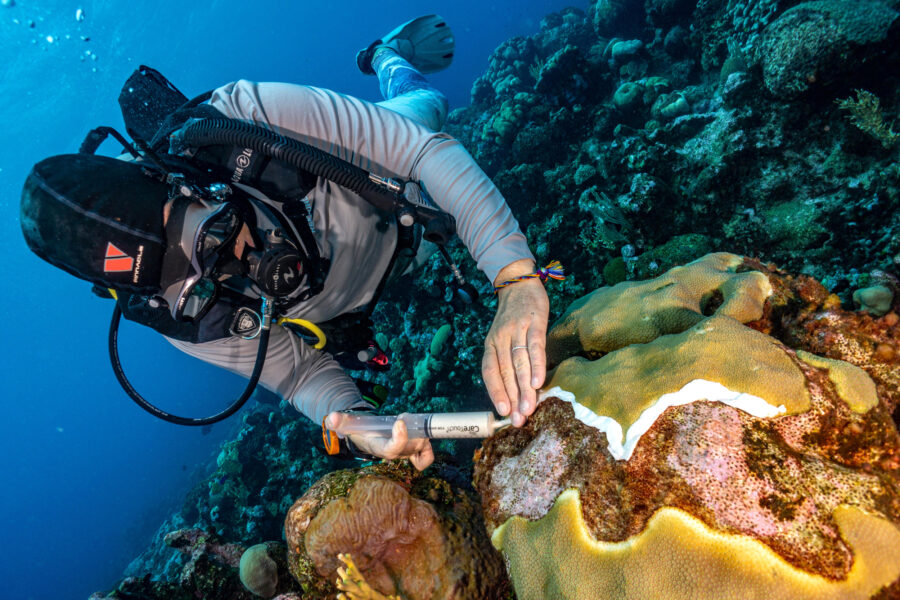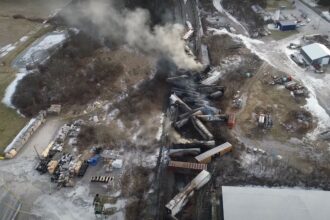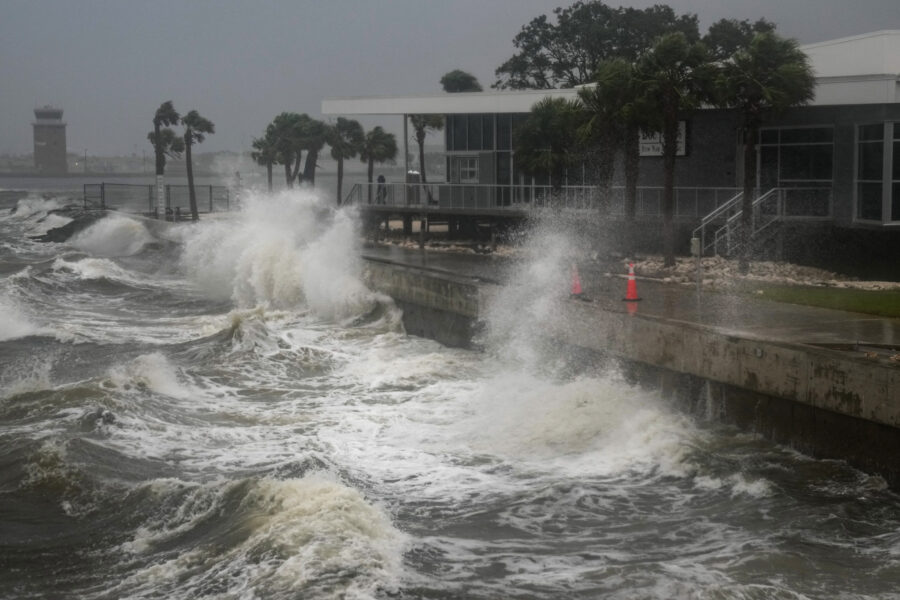Bolivia Has National Rights of Nature Laws. Why Haven’t They Been Enforced?
RURRENABAQUE, Bolivia—The day the fire came, Dario Mamio Serato remembers that he could not breathe. The Amazon rainforest, known as the lungs of the Earth, was an inferno.
Acrid smoke engulfed Mamio Serato as he drove his machete through the jungle’s thick brush. The act was aimed at removing the fire’s fuel and keeping the blaze from reaching three Indigenous Tacana villages from which dozens of women and children had yet to evacuate.
The slice of rainforest they call home had never burned before. But the region was enduring an unusually prolonged dry season. Rivers and streams, the lifeblood of the forest, were parched. The expected rainy season hadn’t come. Now the fire was moving at a breakneck speed, closing in on Mamio Serato’s village.
Lungs burning and limbs heavy, Mamio Serato felt himself succumbing to the physical punishment of the past 12 hours. At 30, he was the only Tacana leader left standing between the fire and the villages. The communities’ elders had evacuated to nearby towns. Watching the orange blaze overtake the most remote Tacana homes, Mamio Serato thought, “We lost.”
Explore the latest news about what’s at stake for the climate during this election season.
That’s when a nearby town’s fire brigade appeared, straight from fighting another blaze. Together, they and the Tacanas set counter burns, stopping the fire’s advance. The main villages were saved, but a new era of fire in the Bolivian Amazon had just begun. Just under a year later, Bolivia’s Amazon rainforest and the wider lowland region is again on fire.
Mamio Serato, in a text message sent in September, said the air in and around the nearby twin Amazonian towns of Rurrenabaque and San Buenaventura has been thick with noxious smoke and the day looks like night, a portend of what could again come to his Tacana village in the weeks ahead.
Laws that ought to help have proved far less powerful than the flames.
The New Normal
In 2010 and 2012, Bolivia did something bold: It enacted national laws recognizing the rights of Pachamama, or Mother Earth.
Such rights of nature laws are a dramatic departure from the status quo, where legal systems treat all non-human life forms as chattel, the property of humans. In those frameworks, a life-sustaining ecosystem is no different than a microwave or a car. That thinking, rights of nature proponents contend, has led to the environmental problems that endanger the world and everyone in it.
But Bolivia’s Mother Earth laws are widely perceived as watered down and unenforceable. More than a decade in, they’re not helping people like Mamio Serato as they fight for the Amazon—a battle that’s just as much a fight for life around the globe.
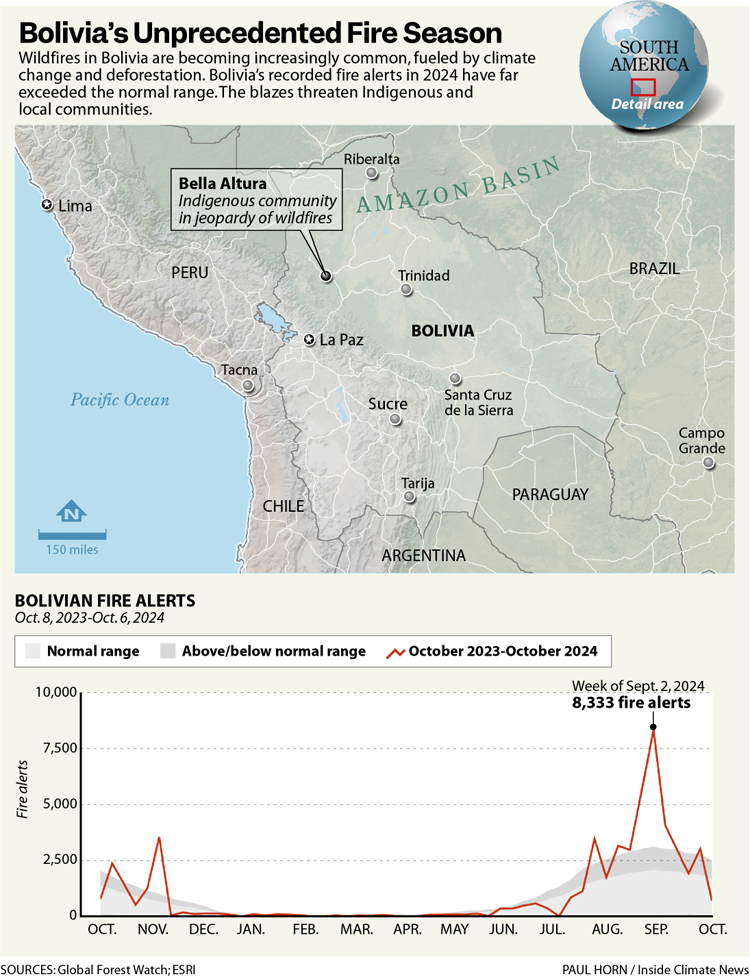
It is, historically speaking, not unusual for parts of the rainforest to burn. Some natural wildfires are expected during the forest’s dry season that runs from about May through the end of October every year.
But what is happening in Bolivia now is not normal.
This year’s fire season is the country’s worst on record, with flames eating five times as much forest as they did 20 years ago. As of Sept. 30, more than 10 million hectares (24.7 million acres) of Bolivia’s rainforests, wetlands and grasslands have burned, according to a report from the Bolivia-based nongovernmental organization Fundacion Tierra. That equates to an area roughly the size of the U.S. state of Indiana. This year, the report said, “will remain in the memory of Bolivians as the year of the worst environmental disaster in Bolivian history.”
The fire problem is bigger than Bolivia. Other countries in South America—home to the world’s largest tropical forest, millions of non-human species and hundreds of communities—are also having record-breaking fire seasons this year.
The Amazon rainforest is becoming more susceptible to fire due to decades of mass deforestation that deprive it of its natural cooling water cycle. Scientists call that cycle transpiration, and it happens when trees pull water through their roots and release moisture from their leaves, leading to rainfall. But land clearing disrupts that balance, leading to more drought-prone conditions, further exacerbated by climate change and natural weather patterns like El Niño. In a reinforcing cycle, more carbon dioxide is released into the atmosphere as forests burn, worsening the conditions that lead to fire in the first place.
This human-caused pattern is even more stark when placed within the arc of history. For 65 million years, the Amazon’s natural cycles have persisted, spawning and supporting countless life forms under its canopy. Today, because of humans—or to be more precise, consumers driving the forest’s destruction and people profiting from it—roughly 18 percent of the Amazon has been deforested and an even larger amount has been degraded. Most of that has happened in just the past 50 years. Bolivia’s losses are second only to Brazil’s.
The drivers of tree loss in the Bolivian Amazon are well known: the expansion of agricultural plantations and cattle pasture; mining, both legal and illegal; logging and other forms of resource extraction; and development. The Bolivian government has largely incentivized this destruction through permissive laws and policies that have more heft than its rights-of-nature rules. Much of the materials ripped from the forest are shipped overseas to consumers elsewhere, including the United States.
This fact is not lost on Mamio Serato or other locals, nor is the role that climate change is playing in intensifying the problem. No one is better positioned to notice the increasing unpredictability in rainfall or the changing temperatures than the forest’s inhabitants.
But when Mamio Serato and I met at his village in Bella Altura in June to talk about this, he pointed to a third, often overlooked culprit—flawed thinking.
Facing a Giant
Bella Altura, a rainforest hamlet with less than 100 inhabitants, sits at the end of a winding dirt road that mirrors the meandering Beni River. For as far as the eye can see, lush rainforest envelops nearly everything around the village, from the one-story brick homes to the mountainous cliffs in the distance.
Mamio Serato was born and raised here, leaving only briefly to attend university in Beni, Bolivia. Like other Indigenous people of his generation, Mamio Serato received two forms of education: one from the outside world, and one from his Tacana elders. It was the latter who taught him the lessons passed down from their parents and grandparents, like how to hunt and fish, to identify and use plants, and to find where animals go to reproduce and feed. That knowledge is a cornerstone of Tacana culture and livelihoods, and it is something that can’t be transmitted to future generations without a healthy, thriving territory.
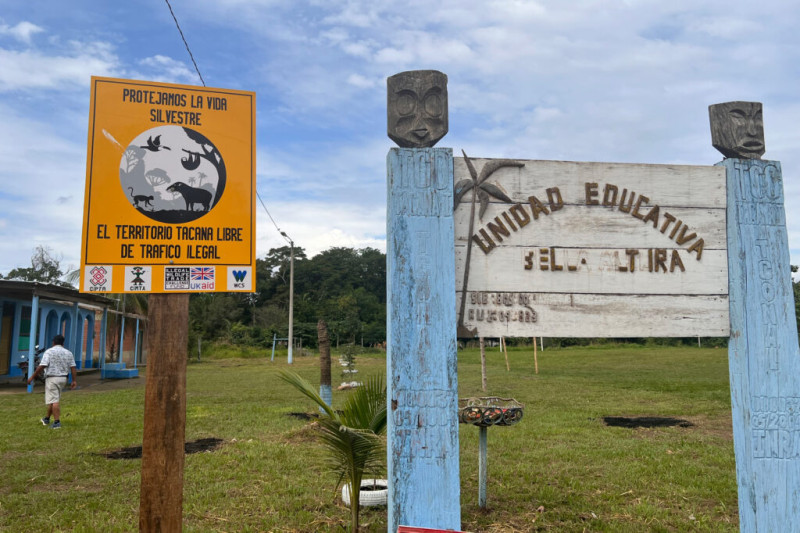
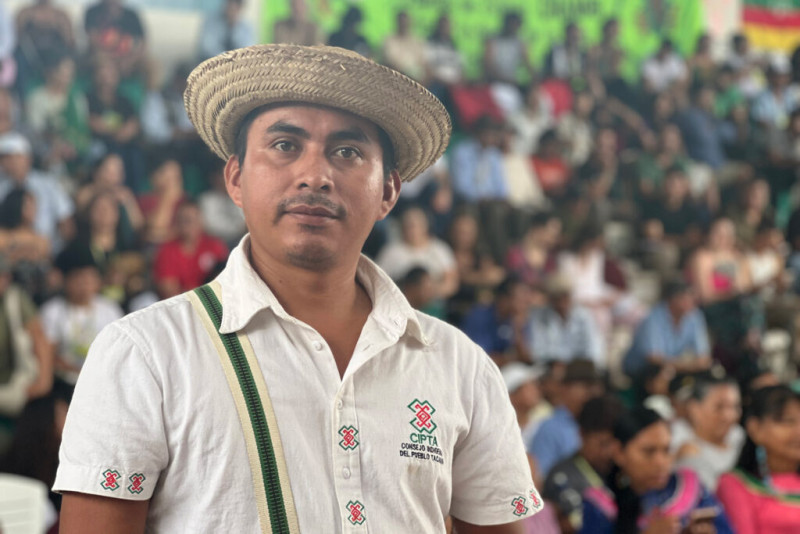
But today, Bella Altura is one of 22 Tacana communities standing on a frontier where massive palm oil and sugar plantations threaten to eat up their homelands. A bird’s-eye view of the region shows a sick, fragmented forest veined with roads, colonization and plantations spreading like disease.
In June, Bella Altura hosted representatives of other forest communities from across South America facing similar threats. They gathered to share experiences and tactics for defending their territories. Despite their distinct cultures, the group of about 50 people had a core commonality: They all agreed that their human communities are interdependent with the natural communities within which they live.
“We are part of nature,” Mamio Serato, speaking in Spanish, told the gathering. “Indigenous people know this. Who will defend nature if not us?”
Mamio Serato was raising two immutable facts. First, that humans are part of nature and dependent on the natural world for survival. It doesn’t matter how many stories we in mainstream society tell ourselves about human exceptionalism or how many skyscrapers and walls we build to cordon ourselves off from nature. Humanity will always owe its existence to the Earth.
The other fact: Without the Indigenous people protecting the forest from violent land grabbers, mining companies and other extractive forces, the Amazon would be far smaller today.
Often, Indigenous and other forest people pay a heavy price for refusing to cede their ways of life and ancestral lands to people wishing to treat those lands like commodities. Every year, hundreds of environmental defenders are killed, harassed and threatened.
That includes Mamio Serato, who last year launched a social media campaign to block the expansion of palm oil plantations near Bella Altura. Almost immediately, he said, he received anonymous phone calls saying that if he didn’t end the campaign, he would be hurt and his family and community would be at risk.
“I was scared, of course I was scared,” Mamio Serato said of the experience. “I am just one facing a giant.”
Today, it has never been clearer that the sacrifices of land defenders like Mamio Serato benefit people living around the world, from farmers in middle America to fishermen in Southeast Asia. The living Amazon stores vast amounts of carbon dioxide, making it a buffer against worsening climate change. If humans continue destroying it, we and future generations will live in a much more volatile world, one with fewer wonders as we drive the forest’s jaguars, sloths, monkeys, pink dolphins and other beings to extinction. Forest people, in defending their territories, defend the world too.
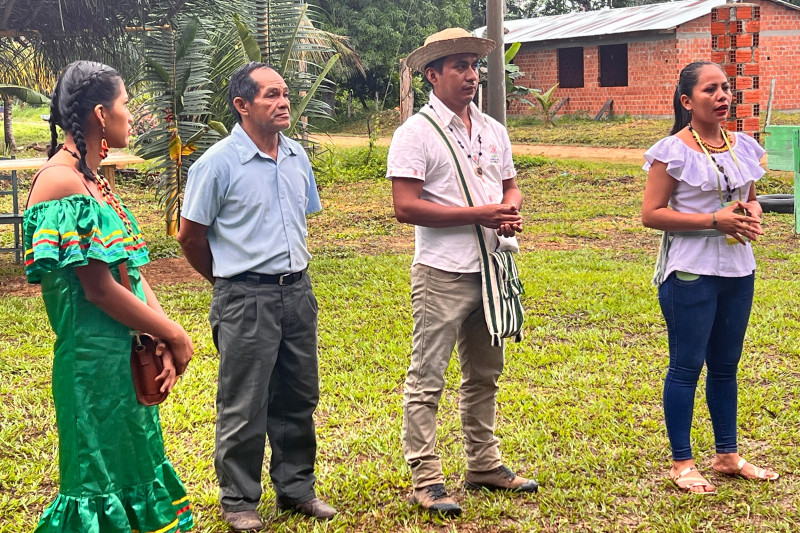
But unlike many of us, who by circumstance or choice know little about the kaleidoscope of Indigenous cultures, people like Mamio Serato have learned to navigate both their world and ours. In recent years, they’ve been using that bi-cultural knowledge to mainstream their understanding of humanity’s interconnectedness with nature into legal systems.
At the gathering in Bella Altura, communities from Peru, Brazil and Ecuador shared stories of how they, against the odds, cemented rights of nature into law. They are part of a loosely coordinated movement responsible for more than a dozen countries recognizing, in some form, that nature has rights.
Mainstream legal systems have long recognized that entities, not just humans, have legal rights—specifically economic entities like corporations and trusts. In the United States, free speech rights allotted to corporations enable them to give unlimited sums of money to political candidates.
But getting governments to recognize nature’s rights is not in itself a panacea for a country’s environmental sickness. At the gathering, Mamio Serato made this point clear when he spoke about Bolivia’s Mother Earth laws: “The end result,” he said, “was very different from what we expected.”
Mother Earth
Mamio Serato was 12 years old when Bolivian Indigenous groups convened in Cochabamba in 2010 to collectively draft a proposal for national rights of nature legislation.
It was, by all accounts, a high moment for the country’s lowland Indigenous groups. A few years earlier, those groups, together with a coalition of laborers, highland Indigenous people and rural poor, had launched Evo Morales into the presidency. Morales, an ethnic Aymaran, was the first Indigenous Bolivian to run the country after centuries of rule by an elite class of European descendants.
Soon after taking office in 2006, Morales delivered on his campaign promise to carry out a “decolonization” process. Relying on revenue from natural gas production, Morales’ Movement Toward Socialism party, or MAS, funded generous social programs, lifting millions of people out of poverty. The MAS also carried out a slate of reforms including land redistribution, nationalizing energy companies and increasing the representation of Indigenous people and women in government. In a 2009 constitutional rewrite, the party made Bolivia a plurinational state, recognizing the country’s 39 distinct Indigenous groups.
Morales took his brand of eco-socialism to the international stage. In the spring of 2009, he gave a blistering speech to the United Nations General Assembly, denouncing capitalism as a seductive and destructive force and making the case for universal recognition of nature’s rights.
“We are strangling the planet, strangling ourselves,” he told diplomats, emphasizing that humans “don’t own the planet, we belong to it.”
A year later, in April 2010, Morales countered a disappointing 2009 climate conference by hosting a global people’s conference in Cochabamba. There, 30,000 participants from more than 100 countries, including some Bolivians who had walked dozens of miles to attend, wrote the non-binding Universal Declaration on the Rights of Mother Earth. Bolivian attendees also stitched together over the course of months a proposal for Bolivia’s own rights of nature law.
But it soon became clear that Morales’ economic model and political coalition were unsustainable. As the world’s China-fueled commodities boom burst and Bolivia’s export revenues plummeted, Morales doubled down on intense resource extraction and agricultural expansion to pay for his social justice agenda.
This created tensions with environmentalists and lowland Indigenous communities. In 2011, the year after the first rights-of-nature law passed, Morales ordered the Bolivian armed forces to disperse Indigenous groups protesting the construction of a highway through a protected part of the Amazon known by its Spanish acronym TIPNIS (Territorio Indígena y Parque Nacional Isiboro-Sécure).
Several Indigenous leaders and high-profile Morales supporters publicly broke ranks with the president around that time. That included Morales’ former ambassador to the United Nations, Pablo Solón, who had been one of the administration’s biggest supporters of environmental and Indigenous rights.
“The most important concern for the government became how to retain power,” Solón said.
Morales did this by bringing some Indigenous leaders into government and directing public funding toward pet projects, according to Solón. The result was a less independent civil society, division among some Indigenous groups and an overall weakening of the Indigenous movement in Bolivia, Solón said. At the same time, the administration grew closer to the agri-business and mining sectors.
In their 2021 book “The Politics of Rights of Nature,” Craig Kauffman and Pamela Martin wrote about the differences between Bolivia’s Mother Earth legislation and Ecuador’s 2008 constitutional recognition of the rights of nature. The latter has been invoked in dozens of cases to defend ecosystems’ rights. Bolivia’s has yet to be enforced.
The authors traced Bolivia’s non-use of its Rights of Mother Earth laws to a divided Indigenous movement, the Morales government’s extractivism for social redistribution and weak language in the laws.
In a recent interview, Kauffman offered an explanation for why Morales may have made these choices. The former president, who hails from Bolivia’s highlands, has a fundamentally different conception than lowland Indigenous groups of how humans relate to land, Kauffman said.
To explain his point, Kauffman pointed to two strikingly different Spanish terms for land. Territorio, used by lowland Indigenous people, speaks to humans’ relationship and reciprocity with land. Tierra, used by highlanders, signifies that land is an extractive resource.
Highlanders, Kauffman said, identify as Bolivia’s original peoples but not as Indigenista, the term used to describe lowland Indigenous people like Mamio Serato. Many Originarios, Kauffman said, now live in cities as part of the urban poor or middle class and have a foundationally different view of nature than Indigenous communities living within the forest.
The Bolivian embassy in Washington, D.C., the Bolivian Ministry of Environment and Water and Morales did not respond to requests for comment.
In June, at a cafe near the Rurrenabaque central square, Mamio Serato told me about the disappointment he felt, seeing the grassroots Mother Nature proposal transformed into something unrecognizable. “The government was so smart in what it did,” he said.
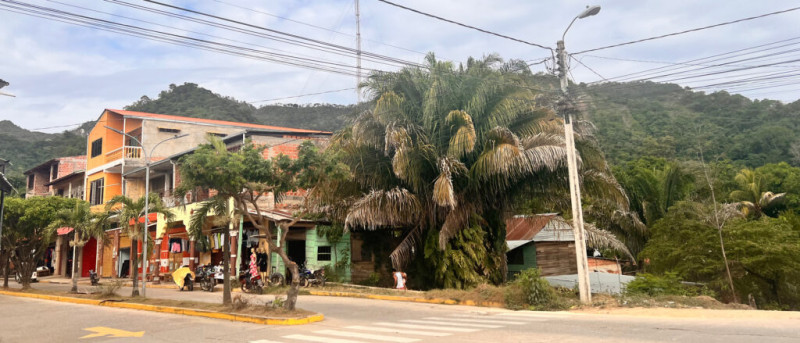
Sipping on a grape juice slushie as people whirled by on tuk-tuks, Mamio Serato explained the myriad of obstacles he has faced trying to enforce the rights of nature in Bolivia. Beyond watering down the legislation, Mamio Serato said, the government has pressured some communities that lack economic alternatives to accept development. Officials have failed to enforce existing protective laws, he said. And they’ve enacted contradictory laws that allow and incentivize logging, mining and slash-and-burn agriculture.
In Bolivia, for example, fines for illegally clearing forest with fire are less than $20 per hectare, which is about 2 percent of what Brazil imposes for similar environmental crimes. Cleared land is more economically valuable than the standing forest, and the fines are too small to change that equation.
“The government tells the world that we have Mother Earth laws, but inside the country they do everything they can to stop us from actually using those laws,” Mamio Serato said.
A Push to Enforce Nature’s Rights
Today, Bolivia stands on the brink of an economic crisis. Its unbridled development policies have not made up for declines in natural gas production. Public debt has more than doubled since 2014, and today roughly 36 percent of the country lives below the poverty line.
At the same time, the systemic lack of environmental controls have culminated in Bolivia becoming one of the leading countries in the world for tree loss and environmental degradation. Luis Arce, Morales’ successor, has largely continued his predecessor’s policies.
And it is Mamio Serato, and people like him, who are most impacted.
Lately, the Bella Altura community has noticed more fish and animals dying and signs of imbalances in ecosystems. Populations of “black pests,” a local term for rodents, are growing, Mamio Serato said.
Then there are the fires. Beyond the life-threatening danger of runaway blazes, wildfire smoke can cause and worsen a range of health problems, particularly for children and the elderly. In remote regions with little or no access to health care, the hazard is especially dangerous.
“I think the solution lies in remembering that the rights of Mother Earth aren’t the government’s.”
— Fátima Monasterio Mercado, Bolivian lawyer and activist
Loss of mental wellbeing is no less real. With our grape slushies nearly finished, I asked Mamio Serato to talk me through the day of the fire. As my translator conveyed the question, I watched his boyish, oval face contort and turn ashen, and his dark eyes redden. The suffering of that day was etched on his face.
We took a break before continuing. He spoke haltingly about the day after the fire fight, when he and other villagers walked across the blackened grounds of their territory. The sight of the charred remains of monkeys, tapirs and turtles and the felled, lifeless giant Brazil nut trees brought him to his knees.
The community had to endure these losses largely on their own, and still must do so. Mamio Serato has asked local officials to provide the Tacanas with wildfire backpack pumps, a firefighting device used to spray water. The packs run about $200 to $300 apiece and, so far, his request has been unfulfilled.
In a developing country like Bolivia, the price of the packs may seem steep. But contrast that with the reaction to the burning of the Cathedral of Notre Dame, when people around the world donated nearly $1 billion to the building’s restoration.
Fátima Monasterio Mercado, a Bolivian lawyer and activist, said local communities are largely left on their own to face environmental problems, including wildfire. She said the economic crisis has left firefighters under-resourced, and she blames the government for failing to enforce laws that ban slash-and-burn agriculture during the dry season. “From July onwards, no one should be burning the forest, but the state does nothing,” she said.
Monasterio has been working with different Indigenous and local communities in the lowlands to rebuild the strong social movements that had helped launch Morales into the presidency. This time, though, the idea is to reclaim the rights of nature and find ways to leverage the existing laws and create new ones. They’re doing this by drawing on the experiences of Indigenous communities in other countries, like Ecuador and Peru, that have built grassroots rights of nature movements.
“I think the solution lies in remembering that the rights of Mother Earth aren’t the government’s,” she said. “The proposal came from civil society and now people want to demand that these rights be realized.”
Earlier this year, two Bolivian towns plagued by legal and illegal gold mining issued resolutions declaring themselves free of mining and invoking the rights of Mother Earth. The resolutions, Monasterio said, are a first step.
Bolivian civil society groups “outraged by ecocide caused by the fires and deforestation” are also holding, from Oct. 7 to 13, their own referendum asking citizens to weigh in on the government’s environmental laws. The fires, the consultation’s organizers say, violate the rights of Indigenous peoples and of Mother Earth.
Mamio Serato and his Bella Altura community are part of the renewed push to reclaim nature’s rights. He has been participating in citizens’ assemblies that are drafting proposals for the government on economic alternatives to extractive activity, like agroecology and reforestation. The June gathering reinvigorated Mamio Serato’s resolve to find a way to enforce nature’s rights.
“This connection we have with nature, with our animals and our ecosystems,” he told me, “that makes it impossible for us to stop trying.”
About This Story
Perhaps you noticed: This story, like all the news we publish, is free to read. That’s because Inside Climate News is a 501c3 nonprofit organization. We do not charge a subscription fee, lock our news behind a paywall, or clutter our website with ads. We make our news on climate and the environment freely available to you and anyone who wants it.
That’s not all. We also share our news for free with scores of other media organizations around the country. Many of them can’t afford to do environmental journalism of their own. We’ve built bureaus from coast to coast to report local stories, collaborate with local newsrooms and co-publish articles so that this vital work is shared as widely as possible.
Two of us launched ICN in 2007. Six years later we earned a Pulitzer Prize for National Reporting, and now we run the oldest and largest dedicated climate newsroom in the nation. We tell the story in all its complexity. We hold polluters accountable. We expose environmental injustice. We debunk misinformation. We scrutinize solutions and inspire action.
Donations from readers like you fund every aspect of what we do. If you don’t already, will you support our ongoing work, our reporting on the biggest crisis facing our planet, and help us reach even more readers in more places?
Please take a moment to make a tax-deductible donation. Every one of them makes a difference.
Thank you,
David Sassoon
Founder and Publisher
Vernon Loeb
Executive Editor
Share this article
- Republish
Disclaimer: The copyright of this article belongs to the original author. Reposting this article is solely for the purpose of information dissemination and does not constitute any investment advice. If there is any infringement, please contact us immediately. We will make corrections or deletions as necessary. Thank you.

